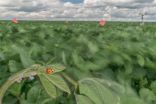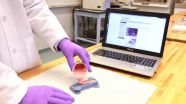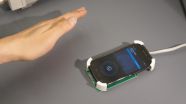(Press-News.org) MADISON, Wis. — Bent and tossed by the wind, a field of soybean plants presents a challenge for an Asian lady beetle on the hunt for aphids. But what if the air — and the soybeans — were still?
Rising temperatures and shifting precipitation patterns may get the lion's share of our climate change attention, but predators may want to give some thought to wind, according to a University of Wisconsin Madison zoologist's study, which is among the first to demonstrate the way "global stilling" may alter predator-prey relationships.
"There are all sorts of other things that are changing in the environment that affect animals and plants and their interactions," says Brandon Barton, a UW–Madison postdoctoral researcher. "My students and I were standing out in a cornfield one day as big gusts of wind came by, and the corn stalks were bending almost double. From the perspective of an animal living in the corn, we thought, 'That's got to have a big effect.'"
Wind speeds in the Midwest are expected to decline as much as 15 percent during the 21st century. Earth's poles are warming faster than the equator, robbing the atmosphere of some of the temperature differential that creates wind. And the trend across the American landscape is to put up barriers to the wind in the form of buildings and more natural structures.
"In North America, we've been replanting trees that were lost in the 1800s, after settlers showed up and just leveled places like New England," Barton says.
That's good news for hungry lady beetles, according to research Barton published in the September issue of the journal Ecology.
Lady beetles eat a major soybean pest, the soybean aphid. Barton grew plots of soybeans in alfalfa fields, protecting some with wind blocks and leaving others in the open.
He found two-thirds more lady beetles in the plots hidden from the wind, and twice as many soybean aphids on the plants growing in the open.
Wind has no direct effect on the aphids, tiny insects that hug the plants and anchor themselves while feeding with a needle-like mouthpart called a stylet.
"The aphids appear on the plants whether it's windy or not, and we showed that in lab experiments," Barton says. "But when you add the predators, with the wind block, the beetles eat something like twice as many aphids."
In his lab trials — simulating wind with fans and windless movement with a machine that tugged on tethered plants to shake and bend them — a stilled soybean plant represented a smorgasbord for the lady beetle.
"How do you do your duty as a predator if you're entire world is moving around?" says Barton, whose work is funded by the National Science Foundation. "If the plant is moving, it takes four times as long for the predator to start eating, and it eats less than half as many aphids in an hour."
Slower natural wind speeds could reduce the amount of pesticide required to keep soybean aphids from wrecking harvests. And the wind research may present other opportunities for pest control.
"By growing trees or not harvesting them around a field, you may be able to have an indirect effect on the number of aphids on your soybean plants," says Barton, who wonders what other close animal relationships may be disrupted by shifting winds.
"The mechanism may be different for other predators, but it's not hard to start thinking about effects," he says. "Think of a wolf or coyote. Larger predators hunting by scent — and the prey trying to detect their predators — may be affected by less wind moving scents around."
INFORMATION:
Chris Barncard
608-890-0465
barncard@wisc.edu
Dwindling wind may tip predator-prey balance
2014-09-19
ELSE PRESS RELEASES FROM THIS DATE:
A two generation lens: Current state policies fail to support families with young children
2014-09-19
September 19, 2014 -- Recent two-generation approaches to reducing poverty that help children and their parents are receiving increasing attention from researchers, advocates, and foundations. By combining education and training for parents to enable them to move to jobs that offer a path out of poverty with high-quality early care and education for children, these programs aim to improve the life opportunities of both. However, according to a new report from the National Center for Children in Poverty (NCCP), State Policies through a Two-Generation Lens, while research ...
Soft robotics 'toolkit' features everything a robot-maker needs
2014-09-19
A new resource unveiled today by researchers from several Harvard University labs in collaboration with Trinity College Dublin provides both experienced and aspiring researchers with the intellectual raw materials needed to design, build, and operate robots made from soft, flexible materials.
With the advent of low-cost 3D printing, laser cutters, and other advances in manufacturing technology, soft robotics is emerging as an increasingly important field. Using principles drawn from conventional rigid robot design, but working with pliable materials, engineers are pioneering ...
Fingertip sensor gives robot unprecedented dexterity
2014-09-19
CAMBRIDGE, Mass-- Researchers at MIT and Northeastern University have equipped a robot with a novel tactile sensor that lets it grasp a USB cable draped freely over a hook and insert it into a USB port.
The sensor is an adaptation of a technology called GelSight, which was developed by the lab of Edward Adelson, the John and Dorothy Wilson Professor of Vision Science at MIT, and first described in 2009. The new sensor isn't as sensitive as the original GelSight sensor, which could resolve details on the micrometer scale. But it's smaller — small enough to fit on a robot's ...
Mayo researchers reveal pathway that contributes to Alzheimer's disease
2014-09-19
JACKSONVILLE, Fla. — Researchers at Jacksonville's campus of Mayo Clinic have discovered a defect in a key cell-signaling pathway they say contributes to both overproduction of toxic protein in the brains of Alzheimer's disease patients as well as loss of communication between neurons — both significant contributors to this type of dementia.
Their study, in the online issue of Neuron, offers the potential that targeting this specific defect with drugs "may rejuvenate or rescue this pathway," says the study's lead investigator, Guojun Bu, Ph.D., a neuroscientist at Mayo ...
A refined approach to proteins at low resolution
2014-09-19
Membrane proteins and large protein complexes are notoriously difficult to study with X-ray crystallography, not least because they are often very difficult, if not impossible, to crystallize, but also because their very nature means they are highly flexible. The result is that when a structure can be obtained it is often of low resolution, ambiguous and reveals a mosaic-like spread of protein domains that sometimes create more puzzles than they solve. [Schröder, Levitt & Brunger. (2014), Acta Cryst. D70, 2241-2255; doi: 10.1107/S1399004714016496 ]
Now, Gunnar Schröder ...
Reflected smartphone transmissions enable gesture control
2014-09-19
With almost all of the U.S. population armed with cellphones – and close to 80 percent carrying a smartphone – mobile phones have become second-nature for most people.
What's coming next, say University of Washington researchers, is the ability to interact with our devices not just with touchscreens, but through gestures in the space around the phone. Some smartphones are starting to incorporate 3-D gesture sensing based on cameras, for example, but cameras consume significant battery power and require a clear view of the user's hands.
UW engineers have developed a ...
Patients with advanced, incurable cancer denied palliative care
2014-09-19
Many patients with advanced, incurable cancer do not receive any palliative care, reveals new research to be presented later this month at the ESMO 2014 Congress in Madrid, Spain, 26-30 September. The findings are astonishing as they come at the same time as 15 new oncology centres in Europe, Canada, South America and Africa are being awarded the prestigious title of 'ESMO Designated Centre of Integrated Oncology and Palliative Care.'
SR I Dr Alexandru Grigorescu, medical oncology consultant at the Institute of Oncology Bucharest, Romania, member of the ESMO Palliative ...
Graphene sensor tracks down cancer biomarkers
2014-09-19
An ultrasensitive biosensor made from the wonder material graphene has been used to detect molecules that indicate an increased risk of developing cancer.
The biosensor has been shown to be more than five times more sensitive than bioassay tests currently in use, and was able to provide results in a matter of minutes, opening up the possibility of a rapid, point-of-care diagnostic tool for patients.
The biosensor has been presented today, 19 September, in IOP Publishing's journal 2D Materials.
To develop a viable bionsensor, the researchers, from the University of ...
Simple test can help detect Alzheimer's before dementia signs show: York U study
2014-09-19
TORONTO, Sept. 19, 2014 — York University researchers say a simple test that combines thinking and movement can help to detect heightened risk for developing Alzheimer's disease in a person, even before there are any telltale behavioural signs of dementia.
Faculty of Health Professor Lauren Sergio and PhD candidate Kara Hawkins who led the study asked the participants to complete four increasingly demanding visual-spatial and cognitive-motor tasks, on dual screen laptop computers. The test aimed at detecting the tendency for Alzheimer's in those who were having cognitive ...
Shrink-wrapping spacesuits
2014-09-19
For future astronauts, the process of suiting up may go something like this: Instead of climbing into a conventional, bulky, gas-pressurized suit, an astronaut may don a lightweight, stretchy garment, lined with tiny, musclelike coils. She would then plug in to a spacecraft's power supply, triggering the coils to contract and essentially shrink-wrap the garment around her body.
The skintight, pressurized suit would not only support the astronaut, but would give her much more freedom to move during planetary exploration. To take the suit off, she would only have to apply ...




